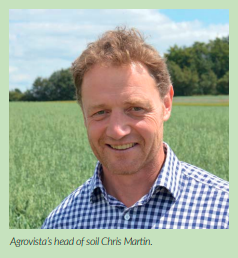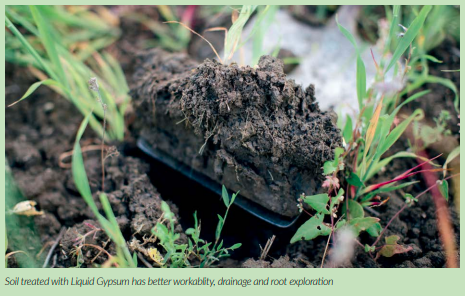Applying gypsum in liquid form could prove particularly beneficial in relieving soil compaction ahead of the autumn sowing programme.
It’s been a tough season for soils. Many fields were drilled in less-than-ideal conditions, often after abandoned earlier attempts at cultivation that left soils prone to slumping, while others were left bare fallow which has done little to improve their structure.
“A good number of fields will need remedial action if growers are to get the best out of next season’s crops,” says Agrovista’s head of soil Chris Martin.

“Carefully targeted loosening will be a priority, but on clay and high magnesium soils, I’ll also be recommending a liquid conditioner to aid aggregation, improving workability, drainage and root exploration to optimise crop establishment.”
Liquid Gypsum provides calcium which is needed to flocculate clays, binding smaller particles together along with clusters of sand and silt. This aggregation is one of the most important keys to a healthy soil, providing a favourable structure that promotes air and water movement, biology and increased root development, says Mr Martin.
“Gypsum has been used to good effect in agriculture for more than 250 years, but applying it in liquid form truly unlocks its many benefits,” he adds.
“Liquid Gypsum is highly soluble and weight for weight is around 2000 times more effective than insoluble granular gypsum. It starts working immediately, acting when and where needed to flocculate the soil throughout much more of the rhizosphere than traditional forms of gypsum.”
Soils treated with gypsum require less energy for subsequent cultivations. The product is applied with a conventional sprayer using traditional water volumes, ensuring fast and accurate application.
Annual treatment is recommended, before or during the cultivation programme, at 5 litres/ha. Liquid Gypsum can be tank-mixed with glyphosate so can be applied during routine stubble-cleaning operations. The improved soil aggregation and permeability that Liquid Gypsum brings also provides an excellent starting point for no-till management systems, says Mr Martin. In this case, a primary application at 10-20 litres/ha should be used.

“Soil health is a key component of the new Agriculture Bill, so reduced tillage will be a key factor in improving and maintaining it.
“The use of gypsum to help improve structure and functionality is likely to increase significantly across the UK, as farmers are encouraged to move less soil mechanically.”
Traditional gypsum sources still have a place, aimed at long-term multi-year effects as only a tiny fraction of these sources will be soluble when applied to the soil, says Mr Martin.
“If you want to get flocculation happening close to the rhizosphere and working on the crop you are growing now, the only option is Liquid Gypsum.”
Liquid Gypsum benefits
• Reduces compaction
• Improves soil porosity
• Lessens soil cracking, run-off and erosion
• Improves high magnesium soils
• Improves soil biology
• Supports crop establishment
www.agrovista.co.uk